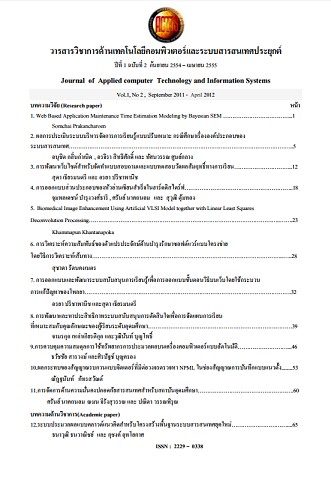Biomedical Image Enhancement Using Artificial VLSI Model together with Linear Least Squares Deconvolution Processing
Main Article Content
Abstract
The optical microscope has seen steady improvement and increasing use in biomedical research and clinical medicine as well as in many other fields. Microscope imaging and image processing are of increasing interest to scientific and medical engineering communities. At dark scenes and under no uniform lighting conditions, either the low intensity areas or the high intensity areas of photon which cannot be clearly seen such as noise, blurring and loss of details. It is the important information for patient’s treatment as well as medical science. Microbiology is an indicator for severity of the disease. In detecting the spread of infection will identify period of the disease. Image processing techniques have been developed to reconstruction the insignificant information under obscure visible. It has various advantages about check the operating room, plague, evidence in court proceedings, public health, genetic engineering and working in the biological warfare.
The most method of enhancement dark image uses calculates contract color level with mathematics model. It returns result for change intensity value at each pixel of original image, and those pixel will brightly than formerly trade lose color in fact. This paper proposes dark image enhancement using Virtual Lights Source Integration (VLSI) model together with Linear Least Squares Deconvolution Processing (LLSD) . It is able to enhance dark image become to brightly and retrieve color in fact of image which are hiding. VLSI will not change directly value of original image, this method to copy vision of human viewer. It is creating new light source and calculate intensity value of each pixel by reflects illumination to visible. This method reduces noise and image enhancement both are medical image and biology. It is robust to over whitening problem. The experiment uses compare between two methods. First, uses a transition function for increasing the dynamic range which is unlimited two hundred fifty five levels color palette of an image and proposes solve a problem an over whitening already. Second, uses VLSI combine LLSD method which is optimal vision and can add information of dark image under less lighting conditions extremely. Result of the experiment, the image enhanced using Virtual Lights Source Integration model together with Linear Least Squares Deconvolution Processing (LLSD) has brightness to good vision and natural colors than previous method which prove using result from equilibrium point of histogram value. VLSI can make up brightness than normality 71.03%-88.06%
Article Details
It is the policy of ACTISNU to own the copyright to the published contributions on behalf of the interests of ACTISNU, its authors, and their employers, and to facilitate the appropriate reuse of this material by others. To comply with the Copyright Law, authors are required to sign an ACTISNU copyright transfer form before publication. This form, a copy of which appears in this journal (or website), returns to authors and their employers full rights to reuse their material for their own purposes.

